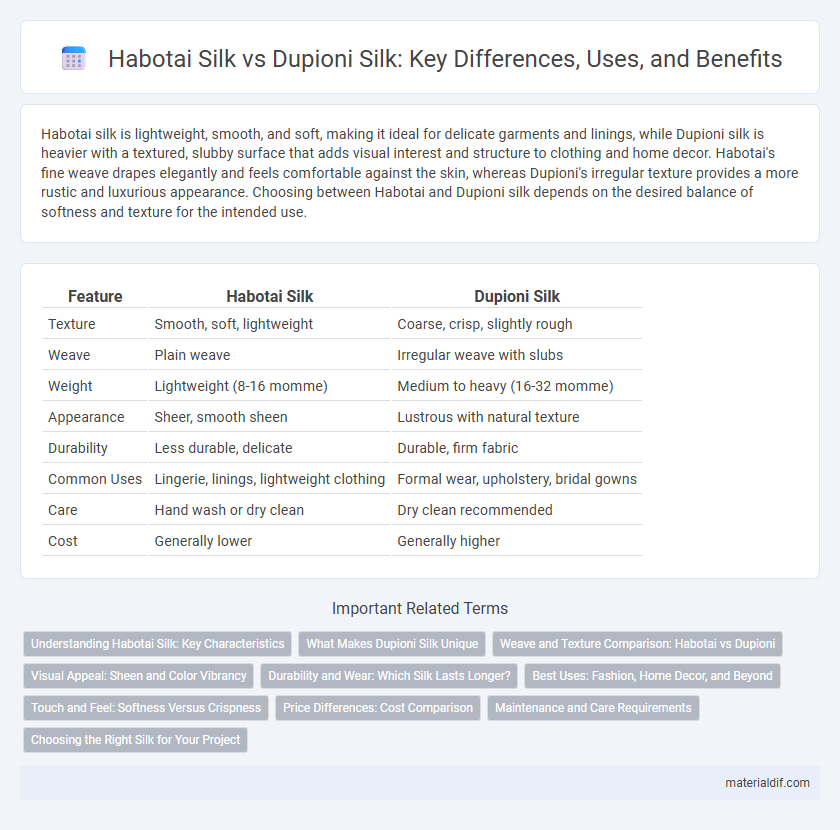Habotai silk is lightweight, smooth, and soft, making it ideal for delicate garments and linings, while Dupioni silk is heavier with a textured, slubby surface that adds visual interest and structure to clothing and home decor. Habotai's fine weave drapes elegantly and feels comfortable against the skin, whereas Dupioni's irregular texture provides a more rustic and luxurious appearance. Choosing between Habotai and Dupioni silk depends on the desired balance of softness and texture for the intended use.
Table of Comparison
| Feature | Habotai Silk | Dupioni Silk |
|---|---|---|
| Texture | Smooth, soft, lightweight | Coarse, crisp, slightly rough |
| Weave | Plain weave | Irregular weave with slubs |
| Weight | Lightweight (8-16 momme) | Medium to heavy (16-32 momme) |
| Appearance | Sheer, smooth sheen | Lustrous with natural texture |
| Durability | Less durable, delicate | Durable, firm fabric |
| Common Uses | Lingerie, linings, lightweight clothing | Formal wear, upholstery, bridal gowns |
| Care | Hand wash or dry clean | Dry clean recommended |
| Cost | Generally lower | Generally higher |
Understanding Habotai Silk: Key Characteristics
Habotai silk is a lightweight, plain-weave fabric known for its smooth texture and fine quality, often used in linings and delicate garments. It features a soft sheen, high breathability, and excellent drape, making it comfortable for warm-weather wear. Unlike Dupioni silk, which has a distinct, slubby texture and heavier weight, Habotai silk offers a more uniform appearance and lighter feel.
What Makes Dupioni Silk Unique
Dupioni silk is unique due to its distinct texture created by weaving two different silk fibers together, resulting in an irregular, slubbed surface that offers a natural sheen and a crisp feel. Unlike the smooth and lightweight Habotai silk, Dupioni has a heavier weight and a more lustrous, iridescent appearance, making it ideal for formal wear and upholstery. The fabric's durability and vibrant sheen are attributed to the dual filament construction and the uneven yarns sourced from twin silkworms spun together.
Weave and Texture Comparison: Habotai vs Dupioni
Habotai silk features a smooth, lightweight plain weave with a soft, lustrous texture ideal for delicate garments and linings. Dupioni silk is characterized by its crisp, irregular slubs and dense plain weave, creating a textured, slightly coarse feel that adds visual interest and body to skirts and jackets. The weave of Habotai is fine and consistent, while Dupioni's uneven yarn thickness produces a distinctive nubby surface, making them suitable for different design aesthetics.
Visual Appeal: Sheen and Color Vibrancy
Habotai silk is known for its smooth, lightweight texture with a soft sheen that enhances subtle color tones, making it ideal for delicate and flowing garments. Dupioni silk features a distinct, lustrous sheen with irregular slubs that create a textured surface, providing vibrant color saturation and a dramatic visual appeal. The color vibrancy in Dupioni silk appears richer and more intense due to its dense weave, contrasting with the gentle, muted hues typical of Habotai silk.
Durability and Wear: Which Silk Lasts Longer?
Habotai silk, known for its smooth, lightweight texture, offers moderate durability suitable for delicate garments and linings, whereas Dupioni silk boasts a heavier, tightly woven structure that enhances its overall strength and resistance to wear. Dupioni's natural slubs and dense weave contribute to superior durability, making it more resistant to abrasion and long-term use compared to the finer, more delicate Habotai. For garments and items requiring longevity, Dupioni silk generally outperforms Habotai in lasting wear and maintaining fabric integrity over time.
Best Uses: Fashion, Home Decor, and Beyond
Habotai silk, known for its lightweight and smooth texture, is ideal for delicate fashion pieces such as scarves, lingerie, and linings, as well as elegant home decor like curtains and pillow covers. Dupioni silk features a crisp texture with natural slubs, making it perfect for structured garments, bridal wear, and statement home decor items like drapes and upholstery. Both silks serve diverse functions in fashion and interior design, with Habotai favored for softness and Dupioni for durability and visual texture.
Touch and Feel: Softness Versus Crispness
Habotai silk offers a smooth, lightweight texture known for its soft, luxurious feel against the skin, making it ideal for delicate garments and linings. In contrast, Dupioni silk features a crisp, slightly coarse texture with a natural sheen and irregular slubs, providing a more structured and textured feel perfect for formal wear and decorative purposes. The tactile difference between Habotai's gentle softness and Dupioni's firm crispness highlights their unique applications in silk textiles.
Price Differences: Cost Comparison
Habotai silk typically costs less than Dupioni silk due to its lighter weight and smoother texture, making it more affordable for everyday apparel and linings. Dupioni silk, known for its heavier, crisp weave with characteristic slubs, commands a higher price because of its luxurious appearance and durability. Price variations depend on factors such as fiber quality, weave complexity, and market demand.
Maintenance and Care Requirements
Habotai silk demands gentle hand washing with mild detergent and air drying to maintain its soft texture and sheen, while Dupioni silk requires more delicate handling, often dry cleaning, to preserve its crisp texture and vibrant colors. Both silks should be stored away from direct sunlight and moisture to prevent fading and damage. Proper maintenance extends the lifespan of Habotai and Dupioni silk garments, ensuring their luxurious appearance over time.
Choosing the Right Silk for Your Project
Habotai silk, known for its lightweight and smooth texture, is ideal for delicate projects such as lingerie, scarves, or linings where softness and drape are essential. Dupioni silk features a crisp finish with natural slubs, providing a textured appearance perfect for structured garments, upholstery, or formalwear that require durability and visual interest. Selecting the right silk depends on the desired fabric weight, texture, and project function, with Habotai offering softness and flexibility, while Dupioni emphasizes strength and distinctive texture.
Habotai silk vs Dupioni silk Infographic

 materialdif.com
materialdif.com